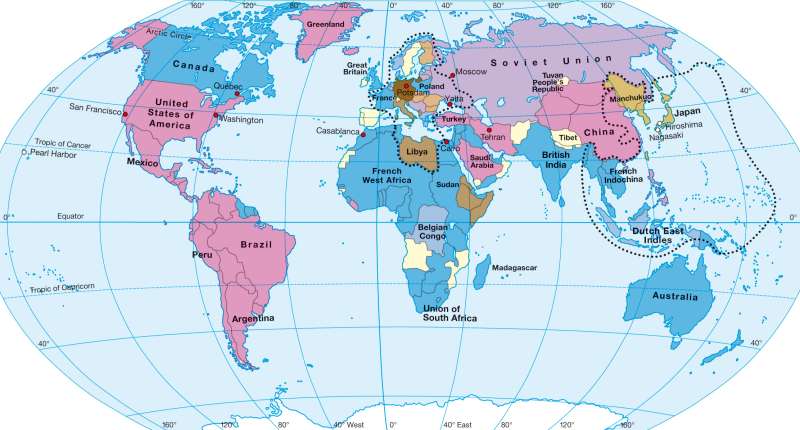World War Two 1939 — 1945 (alliances)
The world - Alliances since World War Two
978-3-14-100790-9 | Page 186 | Ill. 1

Information
The Axis Powers and Their AlliesOn 27 September 1940, in Berlin, a treaty of alliance between Germany, Italy and Japan (Axis Powers) was concluded. At this time, the German Empire's sphere of influence had already spread to large parts of Europe (Czechoslovakia cession of the Sudeten area and the "Accession" of Austria in 1938).In addition, there was the establishment of the Reich Protectorate of Bohemia and Moravia and the annexation of Memellandes (1939), the campaigns in Poland, Denmark, Norway, the Benelux countries and France (1939-40). Italy had occupied Albania in 1939 and in July 1940, it declared war on France and entered into war with Great Britain. In summer 1940, hostilities started in Africa.
In 1939, Japan had led negotiations for an alliance with Germany, but were only included in the summer of 1940 under a new government. From 1937 to 1940, Japan had occupied bases in Korea and large parts of China, where they installed a pro-Japanese government. However, the war could not possibly be won from there. The Axis powers wanted a European sphere of influence (under the predominant control of Germany and Italy) and as well as an established Asia-Pacific sphere of influence (under the authority of Japan).
In 1940, Hungary, Romania and Slovakia were still in the Tripartite Pact, Bulgaria and Croatia followed in 1941. Yugoslavia was divided into German and Italian occupation zones. The Axis powers also included the Italian and Japanese colonies. A satellite regime was installed in Thailand by Japan, and in 1941, the country was forced to enter the war on the side of the Japanese.
Their greatest sphere of influence reached the Axis powers in 1942. Germany occupied Yugoslavia and Greece in 1942 and conquered large parts of the Soviet Union in addition to the already occupied territories until 1940 or 1941. In 1942, Japan had previously occupied almost the whole of Southeast Asia which was under its control, in addition to the Chinese territories.
The aspirational military alliance triangle of Berlin, Rome and Tokyo, also showed cracks despite the co-operation. For example, Japan led failed, parallel secret negotiations with the U.S. on a regime of its own requirements in the Pacific. Japan was permitted by the German Reich to not engage with the war against the Soviet Union.
The Allies and Their Allies
The Soviet Union, Great Britain, the United States and France were confronted with the German expansionism through different strategies. A strong military alliance did not exist at the time. After the German invasion of Poland, there was an agreement between Poland, France and Britain to declare war. Alongside Great Britain, Australia, New Zealand, South Africa, Canada and India also entered the war. Then there were the occupied territories, 1940/41: Norway, Denmark, the Benelux countries, Yugoslavia and Greece. The German invasion of the Soviet Union and the Japanese attack on Pearl Harbor in 1941 caused the United States and the Soviet Union and other countries in Asia and Latin America to become involved in the war. The few exceptions in Europe were Ireland, Sweden, Switzerland, Spain and Portugal. The rest of the world was at war.
There was the existence of an anti-Hitler coalition, but it was deferred until 1942. Although there was agreement in principle on the need for it (January 1, 1942, signing of the Pact of the United Nations, a separate peace with Germany or Japan from the 26 signatory countries excluded). The U.S. and Britain accepted (but not at first) the declared war aims of the Soviet Union on 26 May 1942, which led to the British-Soviet alliance. However, part of the Soviet Union remained suspicious, especially since the Western allies were reluctant to establish a second front in France, from the promised Soviet Union relief. On the other hand, United States and Britain continued to work closely together (with joint headquarters in Washington, with the meeting of Roosevelt and Churchill in Quebec). At the Casablanca Conference in January 1943, both countries agreed to unconditional surrender of the Axis powers as a common war aim.
In Cairo, they agreed schemes with China for the future of East Asia (Korea's independence and the return of Taiwan). The first tripartite meeting was concluded in late 1943 in Tehran. Churchill, Roosevelt and Stalin agreed on a more strategic approach: invasion of France in 1944, a new boundary in central Europe, the division of Germany after the war. In February 1945 in Yalta, Stalin, Roosevelt and Churchill agreed on the Crimea, with the inclusion of France as an occupying power in Germany, which confirmed the new borders in East Central Europe and laid the groundwork for the UN.
At the first tripartite meeting, which came at the end of 1943, the question of reparations remained unclear. In 1945, in Potsdam, the new order in Central and Eastern Europe was negotiated by the victorious powers. In Asia, the war ended on 2 September 1945, with the unconditional surrender of Japan.
M. Felsch; Ü: C. Fleming




